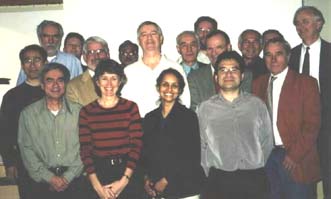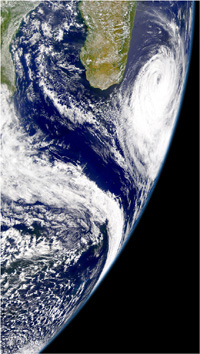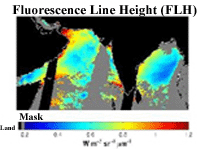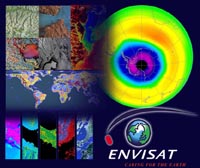

|
|
IOCCG Website Down The IOCCG website was down last week due to technical problems with the server. We regret the inconvenience and apologise to all our subscribers. |
 The IOCCG Committee met for the 7th time last month at the Station Zoologique, Observatoire de Villefranche-sur-Mer, France. The progress of the following IOCCG working groups was discussed:
The IOCCG Committee met for the 7th time last month at the Station Zoologique, Observatoire de Villefranche-sur-Mer, France. The progress of the following IOCCG working groups was discussed:
'Natural Hazards' web page  Tropical Cyclone 10s (Dina), as seen from SeaWiFS on January 24, 2002. Image provided by the SeaWiFS Project, NASA/Goddard Space Flight Center, and ORBIMAGE
Tropical Cyclone 10s (Dina), as seen from SeaWiFS on January 24, 2002. Image provided by the SeaWiFS Project, NASA/Goddard Space Flight Center, and ORBIMAGE NASA recently added a new section called Natural Hazards to its Earth Observatory website, in which it publishes satellite images in near real time over natural hazards around the world, such as the above image of cyclone Dina. Initially, the Earth Observatory team will track five categories of natural hazards: wildfires, severe storms, floods, volcanic eruptions, and major air pollution events (dust storms, smog, and smoke). The images are acquired by NASA's Earth Science Enterprise and Earth Observing System (EOS) satellite missions and are freely available to the public as well as news media.
Blue Marble Image
Science Focus on Fluorescence  The latest Science Focus article from NASA's Goddard DAAC is entitled 'Fluorescence-that healthy glow' by Dr. James Acker. It focuses on how chlorophyll fluorescence can be related to phytoplankton productivity, and explains how fluorescence can be measured using MODIS data. The MODIS bands used for the measurement of chlorophyll fluorescence are 14, 15 and 16 located at 665.1, 676.7 and 746.3 nm. Both the MERIS and MODIS-Aqua sensors, to be launched in the coming months, will have the capability to measure chlorophyll fluorescence. The article is available online at NASA's Goddard-DAAC website.
The latest Science Focus article from NASA's Goddard DAAC is entitled 'Fluorescence-that healthy glow' by Dr. James Acker. It focuses on how chlorophyll fluorescence can be related to phytoplankton productivity, and explains how fluorescence can be measured using MODIS data. The MODIS bands used for the measurement of chlorophyll fluorescence are 14, 15 and 16 located at 665.1, 676.7 and 746.3 nm. Both the MERIS and MODIS-Aqua sensors, to be launched in the coming months, will have the capability to measure chlorophyll fluorescence. The article is available online at NASA's Goddard-DAAC website.
|
SeaWiFS reprocessing update The SeaWiFS Project office, in an effort to keep the ocean-colour community abreast of the reprocessing of the mission, has added a new page to its website. This page lists details of the proposed changes and the results of the preliminary evaluations. The project office anticipates comments and interaction from the ocean colour-community.
 ENVISAT, Europe's largest and most complex satellite ever, is undergoing final preparations at the Space Center in Kourou, French Guiana, for its launch on 1 March, 2002. The environmental satellite will orbit the Earth 14 times a day monitoring for climate change and environmental pollution. Among the satellite's ten highly sophisticated instruments is the Medium Resolution Imaging Spectrometer (MERIS), a 15-band optical sensor spanning the visible and near infrared spectrum, to be used for ocean-colour measurements. The launch campaign had to be interrupted in Mid-July last year because of the failure of the giant Ariane 5 launching rocket during flight 142. Everything is now progressing according to schedule and we look forward to receiving an entirely new ocean-colour data set from MERIS. During the commissioning phase (9 months after launch), full calibration of all Level-1b data products and preliminary validation of the Level-2 data products will take place. MERIS marine products will include algal pigments, yellow substances, suspended matter, aerosol optical thickness, flags, water-leaving radiances and aerosol spectral dependence. For additional information about MERIS data products visit the ESA website.
ENVISAT, Europe's largest and most complex satellite ever, is undergoing final preparations at the Space Center in Kourou, French Guiana, for its launch on 1 March, 2002. The environmental satellite will orbit the Earth 14 times a day monitoring for climate change and environmental pollution. Among the satellite's ten highly sophisticated instruments is the Medium Resolution Imaging Spectrometer (MERIS), a 15-band optical sensor spanning the visible and near infrared spectrum, to be used for ocean-colour measurements. The launch campaign had to be interrupted in Mid-July last year because of the failure of the giant Ariane 5 launching rocket during flight 142. Everything is now progressing according to schedule and we look forward to receiving an entirely new ocean-colour data set from MERIS. During the commissioning phase (9 months after launch), full calibration of all Level-1b data products and preliminary validation of the Level-2 data products will take place. MERIS marine products will include algal pigments, yellow substances, suspended matter, aerosol optical thickness, flags, water-leaving radiances and aerosol spectral dependence. For additional information about MERIS data products visit the ESA website.
MODIS-Aqua launch soon  Aqua, a part of the NASA-centred international Earth Observing System (EOS), is tentatively scheduled for launch on April 18, 2002 aboard the Delta II launch vehicle from Vandenberg Air Force Base, California. The second Moderate Resolution Imaging Spectroradiometer (MODIS) instrument will be one of the six state-of-the-art instruments that Aqua will carry in a near-polar low-Earth orbit. The data from MODIS-Aqua will not be processed until the existing data from MODIS-Terra (launched in December 1999) is stabilised, hence it is expected to take some time before the MODIS-Aqua data is calibrated. MODIS on Aqua is a 36-band spectroradiometer that will measure visible and infrared radiation, and this data will be used to develop a range of products including ocean chlorophyll fluorescence, sea ice cover, cloud and aerosol properties and snow cover on the land.
Aqua, a part of the NASA-centred international Earth Observing System (EOS), is tentatively scheduled for launch on April 18, 2002 aboard the Delta II launch vehicle from Vandenberg Air Force Base, California. The second Moderate Resolution Imaging Spectroradiometer (MODIS) instrument will be one of the six state-of-the-art instruments that Aqua will carry in a near-polar low-Earth orbit. The data from MODIS-Aqua will not be processed until the existing data from MODIS-Terra (launched in December 1999) is stabilised, hence it is expected to take some time before the MODIS-Aqua data is calibrated. MODIS on Aqua is a 36-band spectroradiometer that will measure visible and infrared radiation, and this data will be used to develop a range of products including ocean chlorophyll fluorescence, sea ice cover, cloud and aerosol properties and snow cover on the land.
Science Team Meeting Presentations
Two new employment opportunities for Scientific Programmer/Analysts are available at NASA's Goddard Space Flight Center, USA and three positions for researchers in Marine Science are available at the Royal Belgian Institute for Natural Sciences. See the Employment page for details.
Check out the new references added to the Bibliography and References pages. Please send us your references if you would like to see them incorporated into the bibliography.
|
|
Material for possible inclusion in the IOCCG Newsletter should be submitted to the Project Scientist. If you would like to be placed on the IOCCG News mailing list, and receive a brief summary of the latest news by e-mail (approximately once every 2 months), please send an e-mail with 'subscribe' in the subject line to subscribe@ioccg.org.To unsubscribe from the IOCCG News mailing list please send a message with 'unsubscribe' in the subject line to unsubscribe@ioccg.org.
|
|
|
|